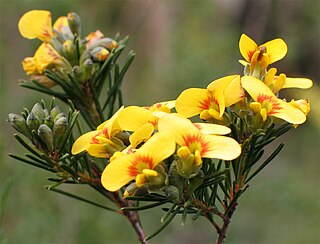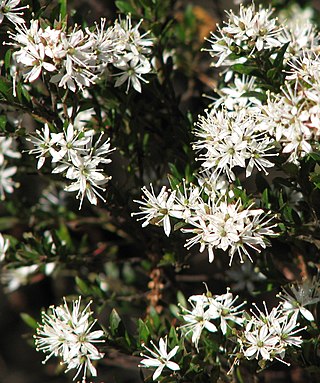
Leptospermum is a genus of shrubs and small trees in the myrtle family Myrtaceae commonly known as tea trees, although this name is sometimes also used for some species of Melaleuca. Most species are endemic to Australia, with the greatest diversity in the south of the continent, but some are native to other parts of the world, including New Zealand and Southeast Asia. Leptospermums all have five conspicuous petals and five groups of stamens which alternate with the petals. There is a single style in the centre of the flower and the fruit is a woody capsule.

Pyracantha is a genus of large, thorny evergreen shrubs in the family Rosaceae, with common names firethorn or pyracantha. They are native to an area extending from Southwest Europe east to Southeast Asia. They resemble and are related to Cotoneaster, but have serrated leaf margins and numerous thorns.

Argophyllaceae is a family of shrubs or small trees belonging to the order Asterales. The family includes c. 24 species in two genera, Argophyllum and Corokia. Members of the family are native to eastern Australia, New Zealand, Lord Howe Island, New Caledonia, and Rapa Iti.

Coprosma is a genus of flowering plants in the family Rubiaceae. It is found in New Zealand, Hawaiian Islands, Borneo, Java, New Guinea, islands of the Pacific Ocean to Australia and the Juan Fernández Islands.

Hakea is a genus of about 150 species of plants in the Family Proteaceae, endemic to Australia. They are shrubs or small trees with leaves that are sometimes flat, otherwise circular in cross section in which case they are sometimes divided. The flowers are usually arranged in groups in leaf axils and resemble those of other genera, especially Grevillea. Hakeas have woody fruit which distinguishes them from grevilleas which have non-woody fruit which release the seeds as they mature. Hakeas are found in every state of Australia with the highest species diversity being found in the south west of Western Australia.

Myoporum is a genus of flowering plants in the figwort family, Scrophulariaceae. There are 30 species in the genus, eighteen of which are endemic to Australia although others are endemic to Pacific Islands, including New Zealand, and one is endemic to two Indian Ocean islands. They are shrubs or small trees with leaves that are arranged alternately and have white, occasionally pink flowers and a fruit that is a drupe.

Persoonia, commonly known as geebungs or snottygobbles, is a genus of about one hundred species of flowering plants in the family Proteaceae. Plants in the genus Persoonia are shrubs or small trees usually with smooth bark, simple leaves and usually yellow flowers arranged along a raceme, each flower with a leaf or scale leaf at the base. The fruit is a drupe.

Dracophyllum is a genus of plants belonging to the family Ericaceae, formerly Epacridaceae. There are 61 species in the genus, mostly shrubs, but also cushion plants and trees, found in New Zealand, Australia, Lord Howe Island and New Caledonia. The name Dracophyllum, meaning dragon-leaf, refers to their strong outward similarity to the unrelated Dracaena, sometimes known as dragon tree. Although dicotyledonous, they resemble primitive monocots with their slender leaves concentrated in clumps at the ends of the branches; they are sometimes called grass-trees.

Kunzea is a genus of plants in the family Myrtaceae and is endemic to Australasia. They are shrubs, sometimes small trees and usually have small, crowded, rather aromatic leaves. The flowers are similar to those of plants in the genus Leptospermum but differ in having stamens that are longer than the petals. Most kunzeas are endemic to Western Australia but a few occur in eastern Australia and a few are found in New Zealand. The taxonomy of the genus is not settled and is complicated by the existence of a number of hybrids.

Pomaderris is a genus of about 80 species of flowering plants in the family Rhamnaceae, the species native to Australia and/or New Zealand. Plants in the genus Pomaderris are usually shrubs, sometimes small trees with simple leaves arranged alternately along the branches and bisexual, woolly-hairy flowers arranged in racemes or panicles. The flowers are usually yellow and often lack petals.

Dillwynia is a genus of about 20 species of flowering plants in the family Fabaceae, and is endemic to Australia. Plants in this genus are shrubs with simple leaves and yellow or red and yellow flowers similar to others in the family.

Cassinia is a genus of about fifty-two species of flowering plants in the family Asteraceae that are native to Australia and New Zealand. Plants in the genus Cassinia are shrubs, sometimes small trees with leaves arranged alternately, and heads of white, cream-coloured, yellow or pinkish flowers surrounded by several rows of bracts.

Hovea is a genus of about forty species of flowering plants in the family Fabaceae, and is endemic to Australia. Plants in this genus are sub-shrubs, shrubs or small trees with simple leaves and purple, blue or mauve flowers with a white centre. The fruit is a pod containing brown to blackish seeds. Species of Hovea occur in all Australian states, the Australian Capital Territory and the Northern Territory.

Leionema is a genus of more than 20 species of mostly small shrubs in the family Rutaceae, most of which are endemic to eastern Australia. Plants within this genus have scented foliage and clustered, star-shaped flowers which range in colour from cream to bright yellow. Prior to 1998, all species within this genus were included in the genus Phebalium.
The Rapa fruit dove is a species of bird in the family Columbidae, which includes pigeons and doves. It is endemic to the island of Rapa Iti in French Polynesia. The species was classified as Critically Endangered by the IUCN Red List in 2018 because of its small population and predicted continued decline. The Rapa fruit dove primarily feeds on fleshy fruit. Its natural habitat is subtropical or tropical moist lowland forests and it has an extent of 30 km2. It is threatened by habitat loss due to deforestation and invasive species. Effective land protection and management could increase the quality of habitat for the species. Additional research into population dynamics and the impact of threats to the species can give a better understanding of the conservation practices needed.

Daviesia, commonly known as bitter-peas, is a genus of about 130 species of flowering plants in the family Fabaceae, and is endemic to Australia. Plants in the genus Daviesia are shrubs or small trees with leaves modified as phyllodes or reduced to scales. The flowers are arranged singly or in groups, usually in leaf axils, the sepals joined at the base with five teeth, the petals usually yellowish with reddish markings and the fruit a pod.

Astelia is a genus of flowering plants in the recently named family Asteliaceae. They are rhizomatous tufted perennials native to various islands in the Pacific, Indian, and South Atlantic Oceans, as well as to Australia and to the southernmost tip of South America. A significant number of the known species are endemic to New Zealand. The species generally grow in forests, swamps and amongst low alpine vegetation; occasionally they are epiphytic.

Leptecophylla is a genus of flowering plants in the Epacridaceae family, a subfamily of Ericaceae. The genus is native to southeastern Australia, New Zealand, Papua New Guinea and the Pacific Islands. Some species in this genus were formerly classified within the genera Cyathodes, Lissanthe, Styphelia and Trochocarpa.

The Tubuai tropical moist forests is a tropical and subtropical moist broadleaf forests ecoregion in French Polynesia. It covers the Austral Islands.

Dracophyllum densum is a species of shrub endemic to north-west Nelson in New Zealand's South Island. It was first described by Walter Oliver in 1952 and gets the specific epithet densum for its leaves growing densely. In the heath family Ericaceae, it inhabits mountain summits, plateaux, and ridge lines and reaches a height of 0.3–0.5 m (1–2 ft). A 2017 assessment using the New Zealand Threat Classification System classified it as “Declining,” giving it an estimated population of more than 100,000.




















